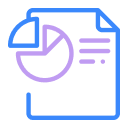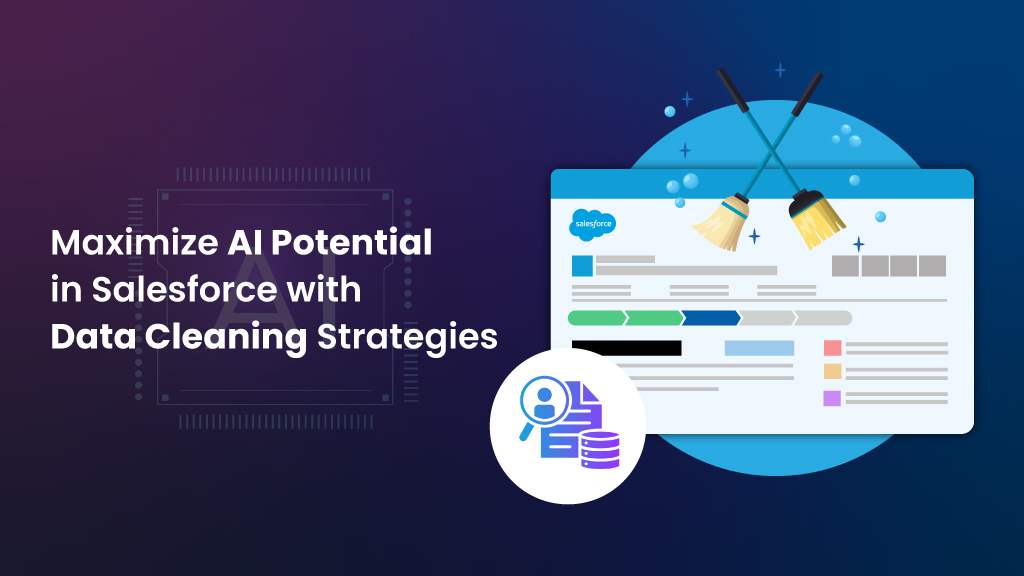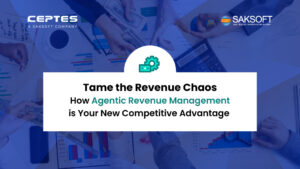In today’s fast-paced business environment, AI has become a key driver of innovation and competitive advantage. If you ask me, Salesforce and AI? Best friends! As businesses seek to leverage AI for deeper insights and better customer experiences, platforms like Salesforce have integrated advanced AI capabilities, such as Einstein Analytics and Einstein Prediction Builder, to empower organizations with data-driven decision-making.
However, the effectiveness of these AI tools is fundamentally tied to the quality of the data that powers them. According to McKinsey, optimizing data quality and availability could unlock up to 40% of the potential value that AI could bring to companies.
This blog explores why Salesforce data cleaning is critical for maximizing AI potential in Salesforce, as is Salesforce data hygiene, and offers practical strategies for ensuring data quality to unlock AI capabilities.
The Data Quality Dilemma: Why It Matters
AI models are only as good as the data they are trained on. Poor data quality leads to inaccurate predictions, flawed insights, and misguided decision-making. In Salesforce, data drives critical AI functions like customer segmentation, lead scoring, and personalized recommendations. When data is inaccurate, incomplete, or outdated, the AI-generated insights are compromised, limiting the potential of Salesforce’s powerful AI capabilities.
Whether you’re aiming to improve sales forecasts, optimize marketing efforts, or enhance customer experiences, clean, reliable data is the foundation of success.
Key Elements of Clean Salesforce Data
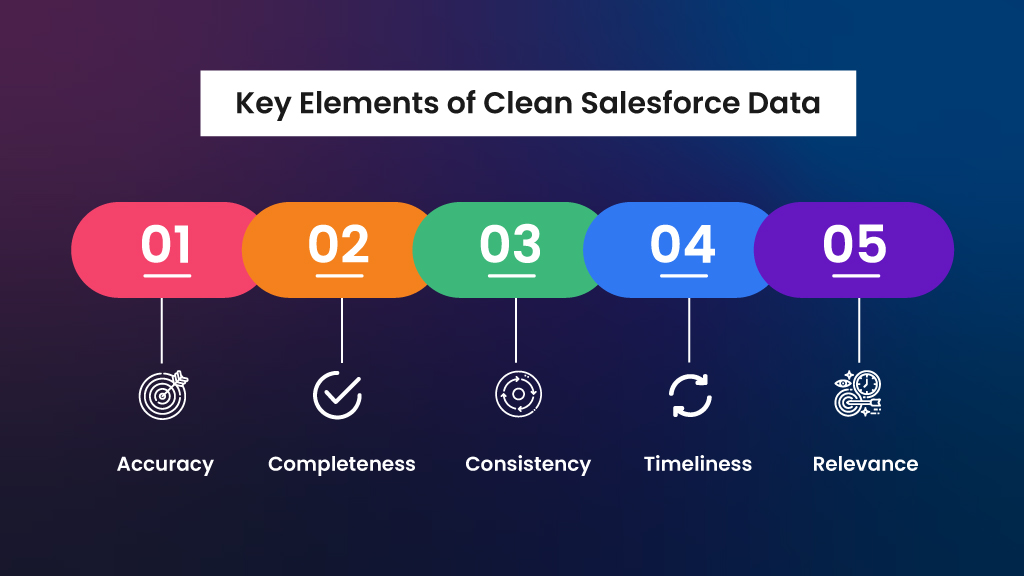
To ensure that your AI initiatives deliver valuable results, it’s crucial to maintain high data quality. Here are the key components of clean Salesforce data that will directly impact your AI outcomes:
1. Accuracy
- Error-Free: Data should be devoid of any inaccuracies, including typos, wrong values, or inconsistencies.
- Validated: Data should conform to predefined formats (e.g., dates in proper format) and meet validation rules for correctness.
2. Completeness
- Populated Fields: Missing data can lead to incomplete analysis, so every relevant field should be filled with appropriate values.
- Data Gaps: Ensure your datasets are fully populated, especially when dealing with time-series data, to avoid skewed AI results.
3. Consistency
- Uniform Formats: Data should be consistent in format across different sources and systems. For instance, date formats should be standardized to prevent errors in analysis.
- Harmonization: Standardize data across systems to create consistency in the way it’s recorded and used.
4. Timeliness
- Up-to-date: AI systems need the most recent data to make relevant predictions. Ensure data is continually updated to reflect the latest business context.
- Ongoing Updates: Data must be updated regularly to capture changes in customer behavior, market trends, and internal business processes.
5. Relevance
- Business-Centric: Ensure that the data aligns with the business objectives you are trying to achieve through AI. Irrelevant data can distort AI models and produce unnecessary noise.
- Actionable Insights: Data should contribute directly to informed decision-making, providing actionable insights.
How Salesforce Data Cleanup Impacts AI Performance
Clean Salesforce data enhances the accuracy, reliability, and efficiency of AI models in Salesforce. When data is well-maintained, businesses can expect:
- Improved AI Accuracy: Clean data leads to more accurate predictions and insights, allowing AI models to deliver better results.
- Reduced Bias: High-quality data helps minimize bias in AI models, ensuring more fair and objective outcomes.
- Better Decision-Making: Trustworthy insights from AI models help businesses make well-informed, data-backed decisions.
- Optimized Resources: Clean data helps identify patterns and trends that guide more effective resource allocation.
- Enhanced Customer Experiences: AI-driven personalization and recommendations rely on clean data to provide relevant and tailored customer experiences.
Salesforce data cleansing best practices
Maintaining clean Salesforce data is an ongoing process that requires commitment and in the case of Salesforce, a proper Salesforce Data Cleaning strategy. Here are some best practices to help you achieve and maintain high data quality for Salesforce AI:
1. Remove Duplicates and Irrelevant Data
- Eliminate Redundancies: Duplicates often arise when data is consolidated from multiple sources. Removing duplicate entries not only streamlines analysis but also improves the efficiency of your AI models.
- Filter Out Unnecessary Data: Data that is irrelevant to the business context (e.g., information on demographics you aren’t targeting) should be removed to avoid clutter and confusion.
2. Fix Structural Errors
- Standardize Formats: Typos, inconsistent capitalization, or variations in similar terms (e.g., “N/A” vs. “Not Applicable”) can throw off AI models. Ensure uniform data entry standards to avoid confusion.
- Consistency Across Fields: Ensure that fields are consistently populated across datasets to prevent misinterpretation by AI systems.
3. Handle Missing Data
- Fill Data Gaps: If critical fields are missing, you can either eliminate the incomplete records or fill in the gaps using imputation techniques. However, be cautious as imputed values are based on assumptions, not real observations.
- Adapt to Missing Data: Alternatively, adjust your analysis to work around missing data, ensuring that AI models still provide actionable insights.
4. Filter Outliers
- Identify and Assess Outliers: Sometimes, outliers may result from data entry errors, but they can also highlight significant patterns or trends. Carefully evaluate outliers before deciding whether to remove or retain them.
5. Validate Data Quality
- Ask Key Questions: After cleaning your data, verify its accuracy and relevance by asking:
- Does the data make logical sense for your AI models?
- Does it conform to predefined validation rules?
- Can it help identify trends and support decision-making?
Real-World Impact: Clean Data in Salesforce AI
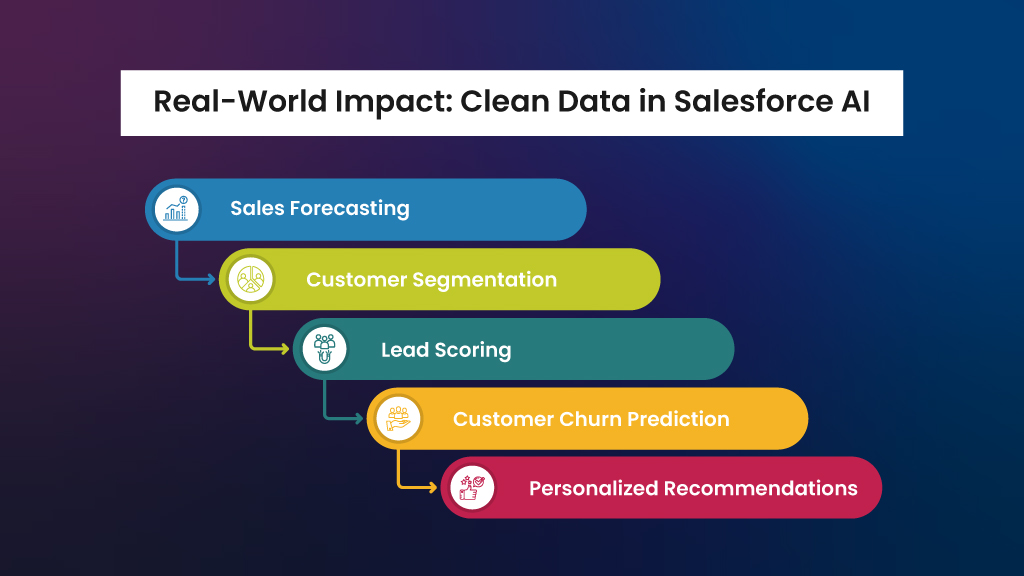
When Salesforce’s AI features are powered by clean data, organizations can achieve transformative outcomes:
- Sales Forecasting: Accurate sales forecasts based on clean Salesforce data help teams allocate resources effectively and improve overall performance.
- Customer Segmentation: Clean customer data allows for precise segmentation, enabling highly targeted marketing campaigns.
- Lead Scoring: AI can score leads more effectively with reliable data, increasing sales efficiency and conversion rates.
- Customer Churn Prediction: Clean data helps identify customers at risk of churning, allowing businesses to take proactive steps to retain them.
- Personalized Recommendations: With high-quality data, AI can deliver more relevant and personalized product recommendations, enhancing the customer experience.
Salesforce Data Cleaning Strategies: Key Pointers
- Data Validation Rules: Implement validation rules in Salesforce to prevent incorrect or incomplete data from being entered.
- Regular Data Audits: Conduct periodic audits to identify inconsistencies, duplicates, and outdated information.
- Utilize Salesforce Optimizer: Leverage Salesforce’s built-in tools like Optimizer or third-party solutions for automated data cleaning.
- Data Deduplication: Apply deduplication techniques using matching algorithms or unique identifiers to eliminate redundant records.
- Automated Data Enrichment: Use automated tools to enrich incomplete records with up-to-date information from trusted sources.
- Data Governance Framework: Establish and enforce data governance policies for consistent data entry, updates, and cleaning.
- Ongoing Monitoring: Continuously monitor your Salesforce data for quality and accuracy to maintain optimal performance.
These strategies will help you maintain clean, high-quality data within Salesforce for better decision-making and AI-driven insights.
AI-Powered Salesforce Data Cleaning
Benefits of GenAI for Data Cleaning:
- Increased Efficiency: Automating the data cleaning process significantly reduces time and effort, making it easier to maintain high-quality data across large datasets.
- Improved Accuracy: GenAI can detect complex patterns and inconsistencies that might be overlooked in manual processes, leading to more accurate data cleaning results.
- Scalability: AI-driven cleaning processes can handle vast amounts of data, making them ideal for businesses working with large, dynamic datasets.
- Reduced Bias: By automating the process, GenAI reduces the chance of human error and bias, ensuring that data is handled objectively.
With GenAI, the data cleaning process becomes much simpler and faster. You train the model on your existing data, allow it to clean the data automatically, and then import the cleaned data back into your system. This process is scalable and can be repeated regularly, ensuring your data remains clean over time.
However, it’s essential to consider the following when implementing AI-powered Salesforce data cleaning in your strategy:
- Data Quality: Ensure that the data used to train GenAI is accurate and complete to avoid cascading errors.
- Algorithm Selection: Choose the right AI algorithms suited to your data structure.
Data Privacy: Adhere to data privacy regulations when using AI for sensitive information.
Lastly, always review and validate AI-cleaned data to maintain its integrity before integrating it back into your system
Wrap-up
Clean data is the foundation of successful AI initiatives in Salesforce. By prioritizing data quality and implementing best practices—such as removing duplicates, handling missing data, and leveraging AI-powered cleaning tools—organizations can maximize the potential of their AI systems. Clean data enables more accurate predictions, better decision-making, and enhanced customer experiences, giving businesses a competitive edge in today’s AI-driven world.
To unlock the full power of AI in Salesforce, invest in maintaining data excellence through a Salesforce data cleaning strategy—it’s the key to long-term success.
Ready to unlock the full potential of AI in Salesforce? Start by prioritizing clean data—contact us today to get started!
FAQs
1. Why is clean data important for AI in Salesforce?
2. What are the key components of clean data for AI models?
3. How does AI-powered data cleaning improve efficiency?
4. What should I consider before using AI for data cleaning?
5. How does clean data impact customer experiences in Salesforce?

Nilamani Das
Nilamani is a thought leader who champions the integration of AI, Data, CRM and Trust to craft impactful marketing strategies. He carries 25+ years of expertise in the technology industry with expertise in Go-to-Market Strategy, Marketing, Digital Transformation, Vision Development and Business Innovation.










